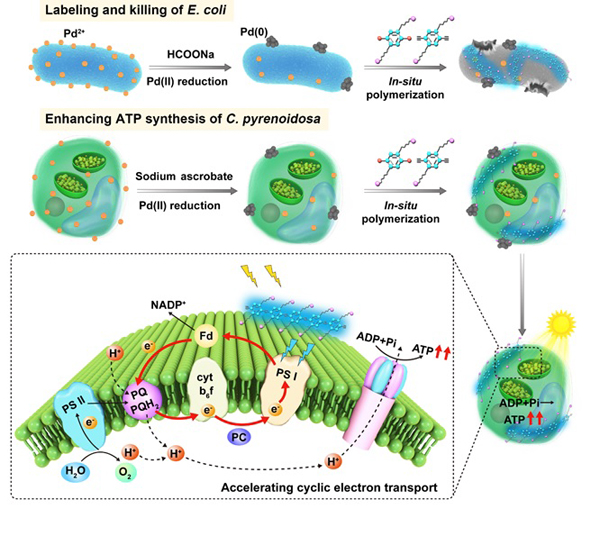In Situ Bio-metal Catalyzed Polymerization Offers New Strategy for Modulating Cellular Functions
Engineering cell surfaces with functional polymers is an effective strategy to modulate the properties of cells. Compared with grafting synthetic polymers to the cell surfaces, in situ generating photoactive polymers on living cell surfaces offer a number of advantages to manipulate and control biological functions.
Recently, a research group led by Prof. WANG Shu at the Institute of Chemistry of Chinese Academy of Sciences (ICCAS) reported a new bio-palladium catalyzed polymerization strategy for in situ synthesis of photoactive polymers on living cell surfaces. This work was published in Angew. Chem. Int. Ed..
The researchers took advantages of the carboxyl, amino, phosphate groups on cells surface to bind Pd (II), and reduce it as bio-Pd nanocatalyst. Following the formation of bio-Pd nanoparticles, the in situ polymerization reaction was subsequently carried out to generate the photoactive polyphenyleneethynylene (PPE) on the cell surface. Since PPE emits blue fluorescence, the polymer formation process on cell surface can be easily traced and characterized.
It is noted that the in situ polymerization strategy displays different results for two kinds of bacteria, for E. coli with specific enzymes on cells, obvious blue fluorescence and higher antibacterial activity was observed, while rarely no fluorescence and low bacteria killing was shown on P. aeruginosa without specific reductive enzymes.
Moreover, the directly formed PPE on C. pyrenoidosa surfaces augmented the ATP synthesis through enlarging the light absorption and accelerating the cyclic electron transport of the algae.
This new bio-metal catalyzed polymerization strategy could make it possible to in situ synthesize other interested functional polymers on the living cell surface, which offers more opportunities for manipulating cell functions.

In situ synthesis of photoactive polymer via bio-Pd catalyst on the cell surface and its antibacterial activity against E. coli and improvement of ATP synthesis in C. pyrenoidosa. (Image by WANG Shu)
contact:
Prof. WANG Shu, Ph.D Principal Investigator
Institute of Chemistry, Chinese Academy of Sciences
E-mail:wangshu@iccas.ac.cn





